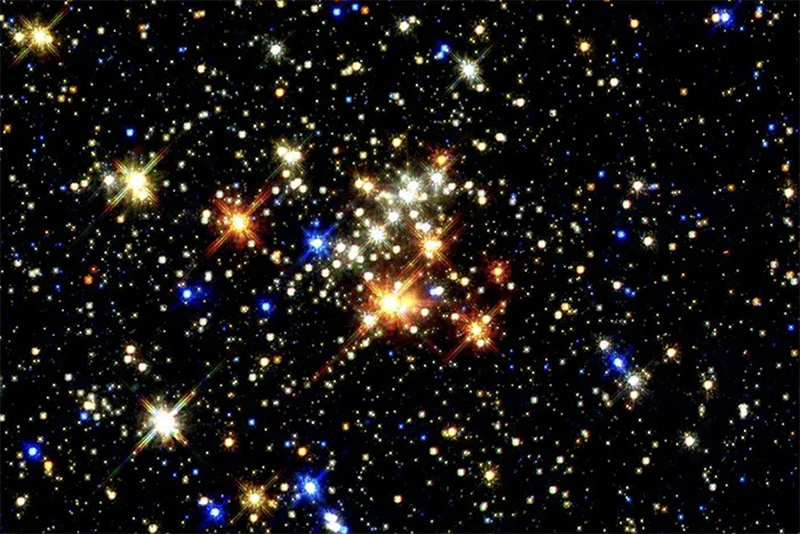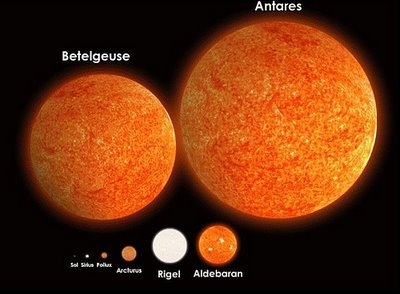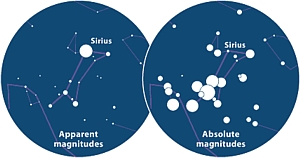A star is a sphere of plasma in hydrostatic equilibrium, which generates energy mainly in the form of light and heat, through thermonuclear reactions. Energy is emitted into space in the form of electromagnetic radiation and stellar wind, mainly. There are a wide number of types, sizes, colors and chemical composition, these parameters varying according to the evolutionary stage of the star.
 They are formed from a cloud of cosmic gas and dust, which at some point begin to agglutinate by gravity, until they become hot enough to generate thermonuclear reactions (nuclear fusion) that will allow them to shine.
They are formed from a cloud of cosmic gas and dust, which at some point begin to agglutinate by gravity, until they become hot enough to generate thermonuclear reactions (nuclear fusion) that will allow them to shine.
Its lifetime depends, among other things, on its initial mass, as well as the way in which a star reaches the final stages of its life depends on this.
Our Sun, in this sense, is a star that is currently in the middle of its life, with enough fuel to survive for about 5,000 million years, after which it will begin some chemical reactions that will turn it into a white dwarf star, with a nebula planetary around it.
Stars, spheres of light
Stars are located at great distances from each other, which astronomers measure in light years (the number of kilometers that light travels in 1 year). From Earth, they appear to us as simple bright points, which "blink" due to interference from the atmosphere. The closest star to us is our Sun, which in astronomical terms is classified as a star. yellow dwarf; There are stars much larger than our Sun, but because they are so far away (both large and small stars), they all seem like simple points of light to us.
We can find stars forming part of a galaxy, a cluster or, more specifically, forming what is known as binary or multiple star systems (composed of 2 or more stars); It is estimated that more or less 75% of all stars are arranged in binary or multiple systems, since our Solar System would be an exception, since it has only one central star (our Sun).
 There are an uncountable number of stars in the Universe. Considering that our Milky Way alone already has some 200 billion, and knowing that there are galaxies much larger than ours scattered throughout space, the number rises incredibly. An analogy is often used that, as impressive as it may seem, sums up this situation very well: "there are more stars in the Universe than grains of sand on all the beaches in the world."
There are an uncountable number of stars in the Universe. Considering that our Milky Way alone already has some 200 billion, and knowing that there are galaxies much larger than ours scattered throughout space, the number rises incredibly. An analogy is often used that, as impressive as it may seem, sums up this situation very well: "there are more stars in the Universe than grains of sand on all the beaches in the world."
This being so, we can form an idea of the vastness of space and all the unexplored corners that we may never be able to know in their entirety. And just as there are many stars, they also have different typologies, which are mentioned in the subsections of this page.
Apparent and absolute magnitude
 From Earth, stars appear to us as simple dots in the night sky, which have an apparent movement actually caused by the Earth's rotation. Because we see the sky in two dimensions, with the naked eye it is impossible to know which stars are further away than others and which are actually brighter, since the brightness with which we see a celestial body from Earth (apparent magnitude) depends on how far away you are.
From Earth, stars appear to us as simple dots in the night sky, which have an apparent movement actually caused by the Earth's rotation. Because we see the sky in two dimensions, with the naked eye it is impossible to know which stars are further away than others and which are actually brighter, since the brightness with which we see a celestial body from Earth (apparent magnitude) depends on how far away you are.
A brighter but more distant star will seem less bright to us than a closer and weaker one, since the latter will appear brighter only due to its proximity to us. To determine the true luminosity (absolute magnitude) and distance from stars, astronomers use a series of techniques and estimates that allow us to understand the Universe in a three-dimensional way.

